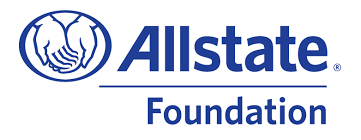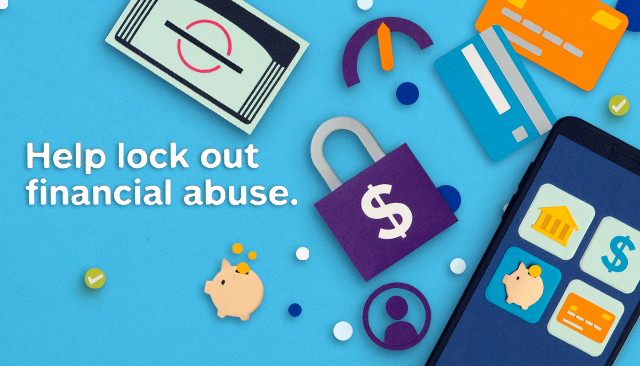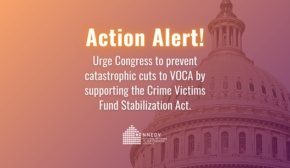NNEDV and The Allstate Foundation: Help Lock Out Financial Abuse
You have the right to safely pursue economic security. However, financial abuse is a common tactic in the context of domestic violence that can jeopardize your safety and financial health. The National Network to End Domestic Violence (NNEDV) and The Allstate Foundation (TAF) are working together to raise awareness and provide resources so that everyone can pursue their financial goals safely.
Domestic violence, which is commonly associated with financial abuse, is a pattern of coercive, controlling behavior. It often begins subtly and progresses over time. Financial abuse is one of the main reasons cited by survivors that they were unable to leave an abusive partner or that they had to return to one. As with all forms of abuse, financial abuse occurs across all socio-economic, educational, and racial and ethnic groups.
Learn more about the proactive steps you can take to financially empower yourself below, in addition to more information about domestic violence, financial abuse, and where to find help for yourself or a loved one.
Credit
One way to take control of your finances and help lock out financial abuse is to learn more about how credit works. This includes:
- Knowing what’s in your credit report.
- Knowing how many lines of credit are open in your name.
- If it makes sense for you, opening a credit card in your name. (While this can decrease your credit in the short-term, using it responsibly over time will increase your score in the longer-term.)
- Making loan payments, including credit cards, on time. If possible, paying more than the minimum amount.
Learn more about understanding your credit in “Module Three: Mastering Credit Basics” of the Moving Ahead through Financial Management Curriculum here.
Security Settings
One way to take control of your financial empowerment and help lock out financial abuse is to use the security settings offered by financial platforms (e.g., banking, credit, and retirement platforms). This includes:
- Understanding how your security settings work.
- Keeping your passwords private.
- Considering using 2-factor
- Considering who else has access to your devices (and by extension your saved information there).
Learn more about password security, including using two-factor or multi-factor authentication, here.
Learn more about iPhone privacy and security here.
Financial Information
One way to take control of your finances and help lock out financial abuse is to protect your personal financial information (e.g., bank account numbers, credit card numbers, etc.). This includes:
- Only accessing your accounts and transmitting financial information over a secure internet connection.
- Considering who else has access to your devices (and by extension your saved information there).
- Securely storing or shredding paper statements.
- Securely removing files and information from your computer, cloud, or mobile devices.
Learn more about protecting your personal financial information in “Module One: Understanding Financial Abuse” of The Moving Ahead Curriculum in English or in Spanish.
Important Documents
One way to take control of your finances and help lock out financial abuse is to secure important documents (e.g., birth certificate(s), social security card(s), documents proving ownership of a home or car, etc.). This includes:
- Considering use of a safety deposit box. If that’s not an option, consider storing these documents at the home of a trusted family member or friend.
- Remember that these documents can be costly or time-consuming to replace. They are often needed to secure employment, obtain safe housing, or transfer assets.
Learn more about securing important documents in “Module One: Understanding Financial Abuse” of the Moving Ahead through Financial Management Curriculum
What is financial abuse?
Financial abuse is a common tactic used by abusers to gain power and control in a relationship. The forms of financial abuse may be subtle or overt but in in general, include tactics to conceal information, limit the victim’s access to assets, or reduce accessibility to shared finances. Financial abuse – along with emotional, physical, and sexual abuse – includes behaviors to intentionally manipulate, intimidate, and threaten the victim in order to entrap that person in the relationship. In some cases, financial abuse is present throughout the relationship and in other cases financial abuse becomes present when the survivor is attempting to leave or has left the relationship.
Every relationship is unique, and there may be no one clear sign of financial abuse. As with other forms of abuse, financial abuse may begin subtly and progress over time. It may even look like love initially as abusive partners often appear very charming and are masterful at manipulation. For example, the abusive partner may make statements such as, “I know you’re under a lot of stress right now, so why don’t you just let me take care of the finances. I’ll give you money each week to take care of what you need.” Under these circumstances, the victim may believe that they should or can trust their partner and may willingly give over control of the money and how it is spent. This scenario commonly leads to the abusive partner giving the victim less and less in “allowance.” By the time the victim decides they want to take back control of the finances, they discover that the accounts have been moved or they no longer have knowledge or access to the family’s funds.
In other cases, financial abuse may be much more overt. Abusive partners commonly use violence or threats of violence and intimidation to keep the victim from working or having access to the family funds. Whether subtle or overt, there are common methods that abusive partners use to gain financial control over their partner, which include:
- Controlling how all of the money is spent. This may include withholding or denying access to bank accounts or assets, or withholding money or giving an allowance that is not mutually agreed upon.
- Withholding funds for the victim or children to obtain basic needs such as food and medicine.
- Excluding the victim from important financial decisions, such as investment or banking decisions.
- Hiding assets.
- Sabotaging work or employment opportunities by stalking or harassing the victim at the workplace or causing the victim to lose their job by physically harming them prior to important meetings or interviews, or forbidding work entirely.
- Forcing the victim to work in a family business without pay.
- Refusing to work or contribute to the family income.
- Ruining the victim’s credit. This could include running up large amounts of debt on joint accounts and refusing to pay bills, or taking out credit cards in the victim’s name without their knowledge.
- Forcing the victim to write bad checks, file fraudulent tax returns, or file false insurance claims.
- Forcing the victim to turn over public benefits or threatening to turn the victim in for “cheating or misusing benefits.”
- Stealing the victim’s identity, property, or inheritance.
- Refusing to pay or evading child support or manipulating the divorce process by drawing it out by hiding or not disclosing assets.
Learn more about financial abuse here or download our Financial Abuse fact sheet here (also available in Spanish here).
What does a healthy financial relationship look like?
Healthy relationships are built on mutual trust and respect. The partners in every relationship should be empowered to openly discuss finances and have an equal say in how financial decisions are made. While each household may choose different arrangements to meet their individual needs, a healthy financial relationship means each person trusts and respects the way financial decisions are made.
In a healthy financial relationship:
- All partners have access to any and all financial statements and information (although one partner might manage the day-to-day finances, while the other pays the bills, etc.).
- Differences in values are negotiated and financial goals are formed jointly (e.g., large purchases or long-term decisions are made jointly).
- All partners recognize and respect that decision-making is equal, regardless of who earns more income or if one is the sole financial provider.
- All partners have access to money and are generally knowledgeable about how and where money is spent.
What should you do if you or someone you know is experiencing financial abuse?
Experiencing financial abuse can be disempowering and isolating, but you are not alone – and you are not at fault. If you need someone to talk to, help is available:
- National Domestic Violence Hotline: 24/7 support at (800) 799-SAFE (7233) or (800) 787-3224 (TTY)
- StrongHearts Native Helpline: 7:00 AM to 10:00 PM (CT) at (844) 7NATIVE
- NNEDV WomensLaw.org: www.WomensLaw.org
- If you are in immediate danger, and feel comfortable reaching out to law enforcement, please call 911.
- Find additional help and resources here.
If a friend or family member is experiencing financial abuse, reach out and be supportive. Here are some tips to keep in mind:
- Start by believing and listening without judgement. Believe, support, and trust survivors. Instead of second-guessing their experiences, rightfully place the responsibility on abusers and perpetrators to end the abuse. Listen to and validate the survivor’s experiences.
- Never blame the victim. Abuse is never the victim’s fault. Be aware of the language you are using. The question is not, “why didn’t the victim just leave?” The better question is, “why did the abuser choose to abuse?”
- Hold perpetrators accountable. Survivors of financial abuse may feel like they were at fault, not only because of the tactics of their abuser and but also because of systems of oppression in our society that make it difficult to achieve financial equality and empowerment, individually and in relationships.
- If it is safe to do so, call offenders out on their abusive actions and impose social consequences, like telling them they’re not welcome for family dinner or to hang out until the abusive behavior stops. Stop excusing behavior with “boys will be boys” or “[the perpetrator] would never do something like that.” Community accountability can make a significant impact.
- Know that help is available. Be aware of what resources are available and offer to help when and if a survivor is ready to seek resources. Knowing what resources are available can help survivors navigate the next step.
- If they are in immediate danger, if you feel comfortable doing so, please call 911, a local hotline, or the National Domestic Violence Hotline at (800) 799-7233 and TTY (800) 787-3224 or the StrongHearts Native Helpline at (844) 7NATIVE
- Find your state or U.S. territory coalition at nnedv.org/Coalitions. Coalitions represent local programs within your state that can provide direct resources, like temporary shelter or safety planning.
- Find tips for having an informed conversation about domestic violence here.
Financial empowerment resources
Moving Ahead through Financial Management
The Moving Ahead through Financial Management Curriculum provides financial empowerment tools within the context of financial abuse. Developed by The Allstate Foundation in partnership with the National Network to End Domestic Violence (NNEDV), it is a great resource for survivors of domestic violence, or for anyone who is looking to improve their financial health and to learn more about the intersections of finance and domestic violence.
Learn more or download the curriculum here.
Financial Literacy Toolkit
NNEDV developed the Financial Literacy Toolkit in order to collect all of the resources it has available to survivors and the general public related to domestic violence, financial abuse, financial literacy, and economic empowerment.
Learn more or download resources from the toolkit here.
Independence Project
The Independence Project is a credit-building micro-lending program for survivors of domestic violence. Through the Independence Project, advocates and local domestic violence programs across the nation can support survivors of domestic violence in improving their credit scores through micro-lending.
Learn more here.
Get Involved Toolkit
There is so much that you can do right now to help make a difference in your community. Check out our Get Involved Toolkit for ideas – like suggesting a book at your next book club, or writing a letter to the editor of your local newspaper.
Learn more or download resources from the toolkit here.
Learn more about The Allstate Foundation
Since 2005, The Allstate Foundation has invested over $66 million to help more than 1.7 million survivors. Whether you’re a nonprofit, an individual looking to contribute or are currently experiencing domestic violence yourself, the following resources are here to help you take action.
Learn more by visiting The Allstate Foundation website here.






